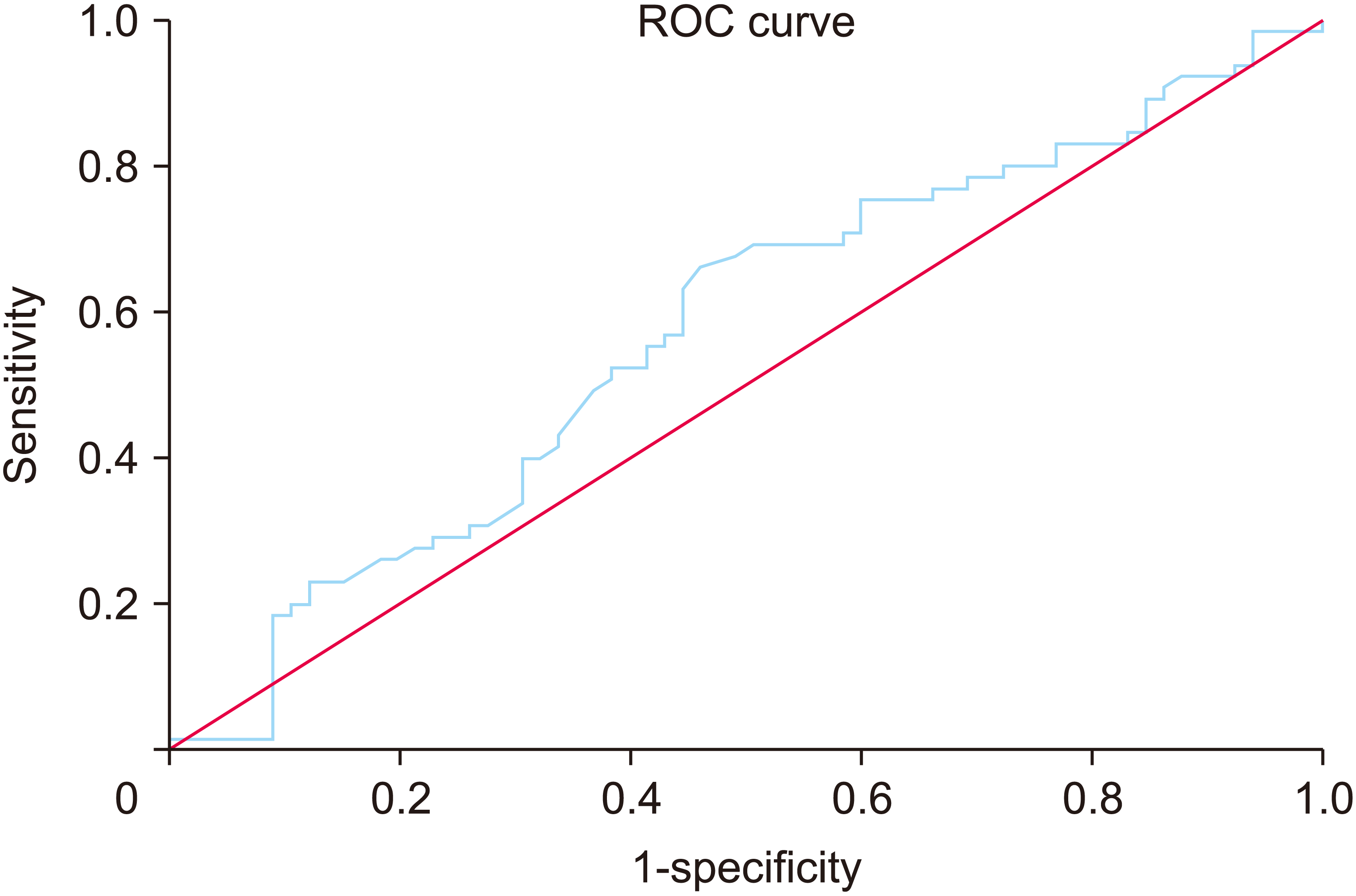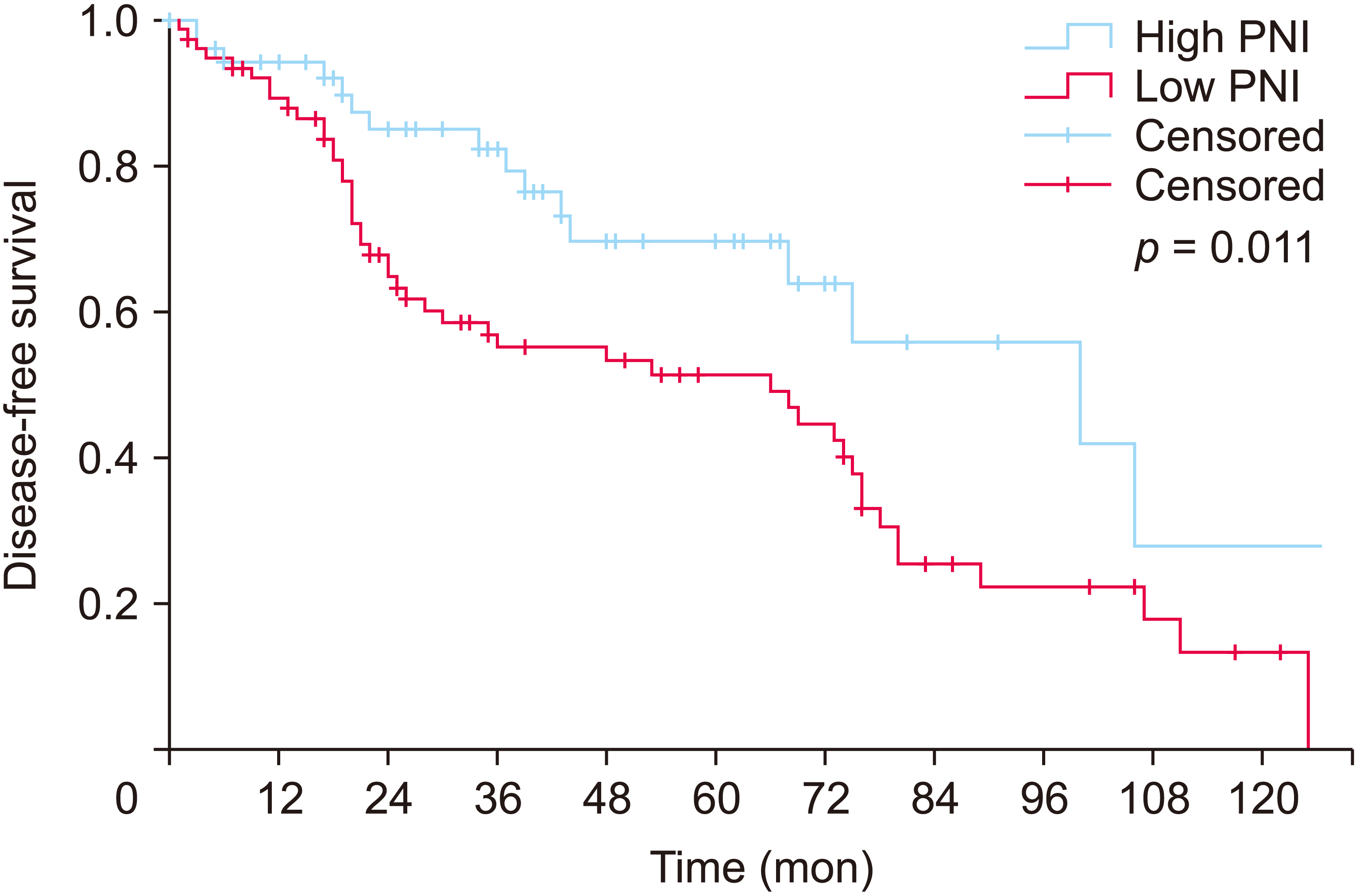Abstract
Backgrounds/Aims
Methods
Results
REFERENCES
Fig. 1

Fig. 2

Table 1
| Variable | PNI-high group (n = 53) | PNI-low group (n = 77) | p-value |
|---|---|---|---|
| Age (yr) | 54 (33–80) | 61 (39–83) | 0.187 |
| Male | 44 (83.0) | 67 (87.0) | 0.616 |
| Hepatitis | 0.097 | ||
| HBV | 41 (77.4) | 44 (57.1) | |
| HCV | 3 (5.7) | 7 (9.1) | |
| Alcohol | 3 (5.7) | 13 (16.9) | |
| Child-Pugh | 0.121 | ||
| A | 51 (96.2) | 67 (87.0) | |
| B | 2 (3.8) | 10 (13.0) | |
| Comorbidity | |||
| Diabetes | 42 (79.2) | 50 (64.9) | 0.116 |
| Hypertension | 34 (64.2) | 48 (62.3) | 0.855 |
| Albumin (g/dL) | 4.4 (3.7–5.2) | 3.9 (2.3–4.8) | < 0.001 |
| Lymphocyte (/mm3) | 2,380 (1,650–6,760) | 1,520 (490–2,620) | < 0.001 |
| Platelet (×103/mm3) | 170 (79–345) | 156 (56–464) | 0.913 |
| PT INR | 0.97 (0.86–1.85) | 1.03 (0.83–1.61) | 0.036 |
| CRP (mg/dL) | 0.15 (0.01–3.02) | 0.26 (0.01–3.89) | 0.150 |
| ALT (U/L) | 29 (10–164) | 31 (4–137) | 0.747 |
| Total bilirubin (mg/dL) | 0.5 (0.19–2.58) | 0.6 (0.17–1.93) | 0.455 |
| AFP (ng/mL) | 20.3 (0.6–15,000) | 7.2 (0.5–11,340) | 0.339 |
| PIVKA-II (mAU/mL) | 58 (10–33,726) | 77 (9–48,555) | 0.157 |
| ICG R15 (%) | 8.3 (1–22.7) | 11.5 (1–32) | 0.079 |
| Estimated blood loss (mL) | 400 (0–2,400) | 600 (0–5,000) | 0.017 |
| Blood loss > 800 mL | 11 (20.8) | 28 (36.4) | 0.079 |
| Intraoperative transfusion | 6 (11.3) | 29 (37.7) | 0.001 |
| Operation time (min) | 260 (95–580) | 230 (65–985) | 0.419 |
| Operation method | |||
| Laparoscopic | 23 (43.4) | 23 (29.9) | 0.137 |
| Nonanatomic resection | 17 (32.1) | 29 (37.7) | 0.692 |
| Major resectiona) | 24 (45.3) | 28 (36.4) | 0.364 |
| Size (cm) | 2.7 (0.8–10) | 3.5 (1–24) | 0.012 |
| Margin (mm) | 11 (1–70) | 10 (1–55) | 0.367 |
| Multiple tumor | 9 (17.0) | 8 (10.4) | 0.299 |
| Edmondson grade | 0.398 | ||
| Grade 1 | 4 (7.5) | 10 (13.0) | |
| Grade 2–4 | 49 (92.5) | 67 (87.0) | |
| Microvascular invasion | 13 (24.5) | 16 (20.8) | 0.671 |
| T-stage | 0.055 | ||
| 1 | 31 (58.5) | 41 (53.2) | |
| 2 | 18 (34.0) | 17 (22.1) | |
| 3 | 0 | 4 (5.2) | |
| 4 | 4 (7.5) | 15 (19.5) | |
| Recurrence | 17 (32.1) | 48 (62.3) | 0.001 |
PNI, prognostic nutritional index; HBV, hepatitis B virus; HCV, hepatitis C virus; PT INR, prothrombin time international normalized ratio; CRP, C-reactive protein; ALT, alanine aminotransferase; AFP, alpha fetoprotein; PIVKA II, prothrombin induced by vitamin K antagonist-II; ICG R15, indocyanine green retention test.
Table 2
| Variable | HR | 95% CI | p-value |
|---|---|---|---|
| Age (≥ 70/< 70 yr) | 0.82 | 0.34–1.95 | 0.661 |
| Sex (male/female) | 1.00 | 0.19–1.45 | 0.601 |
| HBV (+/-) | 0.62 | 0.29–1.28 | 0.198 |
| HCV (+/-) | 1.55 | 0.41–5.77 | 0.513 |
| Alcohol (+/-) | 3.45 | 1.05–11.34 | 0.041 |
| Child-Pugh (B/A) | 1.44 | 0.43–4.82 | 0.546 |
| Diabetes (+/-) | 1.82 | 0.84–3.93 | 0.125 |
| Hypertension (+/-) | 1.70 | 0.82–3.49 | 0.147 |
| Albumin | 0.72 | 0.34–1.51 | 0.392 |
| Lymphocyte | 1.00 | 0.99–1.00 | 0.350 |
| Platelet (/mm3) (≤ 1.0 × 105/> 1.0 × 105) | 1.16 | 0.39–3.41 | 0.784 |
| PT INR (> 1.2/≤ 1.2) | 3.20 | 0.62–16.50 | 0.164 |
| CRP (mg/dL) | 1.16 | 0.71–1.89 | 0.535 |
| ALT (U/L) | 1.01 | 0.99–1.02 | 0.088 |
| Total bilirubin (mg/dL) | 1.46 | 0.60–3.59 | 0.400 |
| AFP (≥ 40/< 40) | 1.61 | 0.77–3.34 | 0.198 |
| PIVKA-II (≥ 200/< 200) | 2.57 | 1.23–5.37 | 0.012 |
| ICG R15 (> 10%/≤ 10%) | 3.86 | 1.71–8.76 | 0.001 |
| Estimated blood loss (≥ 800 mL/< 800 mL) | 2.27 | 1.05–4.93 | 0.037 |
| Intraoperative transfusion (+/-) | 1.73 | 0.79–3.82 | 0.169 |
| Operation time (≥ 300 min/< 300 min) | 1.65 | 0.78–3.49 | 0.188 |
| Laparoscopic resection (+/-) | 0.58 | 0.28–1.20 | 0.144 |
| Non-anatomical resection (+/-) | 1.10 | 0.59–2.08 | 0.748 |
| Major resectiona) (+/-) | 1.67 | 0.82–3.40 | 0.153 |
| Size (cm) | 1.23 | 1.08–1.40 | 0.001 |
| Margin (≤ 10 mm/> 10 mm) | 0.93 | 0.46–1.90 | 0.857 |
| Multiple tumor (+/-) | 2.00 | 0.69–5.78 | 0.199 |
| Edmondson grade (1/2–4) | 1.38 | 0.45–4.22 | 0.573 |
| Microvascular invasion (+/-) | 2.76 | 1.14–6.66 | 0.023 |
| T-stage | 2.07 | 1.38–3.10 | 0.001 |
| PNI (≥ 52/< 52) | 3.50 | 1.67–7.33 | 0.001 |
HR, hazard ratio; CI, confidence interval; HBV, hepatitis B virus; HCV, hepatitis C virus; PT INR, prothrombin time international normalized ratio; CRP, C-reactive protein; ALT, alanine aminotransferase; AFP, alpha fetoprotein; PIVKA-II, prothrombin induced by vitamin K antagonist-II; ICG R15, indocyanine green retention test; PNI, prognostic nutritional index.




 PDF
PDF Citation
Citation Print
Print



 XML Download
XML Download